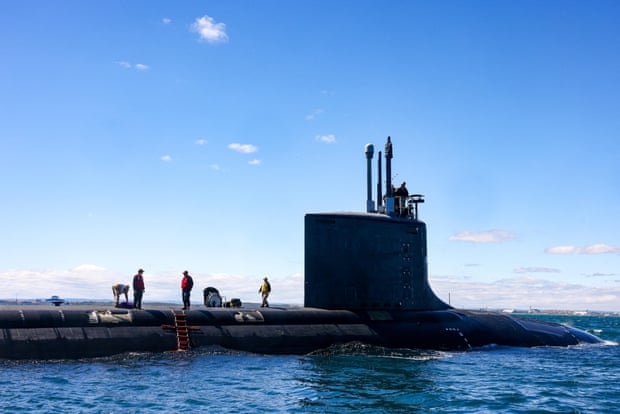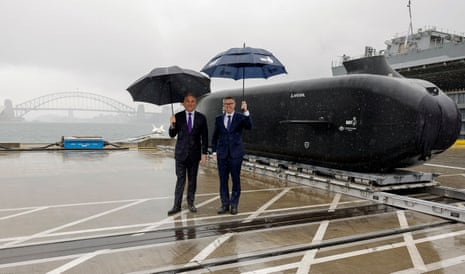Military history is littered with the corpses of apex predators.
The Gatling gun, the battleship, the tank. All once possessed unassailable power – then were undermined, in some cases wiped out, by the march of new technology.
“Speed and stealth and firepower,” the head of the Australian Submarine Agency, Jonathan Mead, told the Guardian two years ago of Australia’s forthcoming fleet of nuclear submarines. “The apex predator of the oceans.”
But for how much longer?
In the first quarter of the 21st century, nuclear submarines have proven a formidable force: essentially undetectable deadly attack weapons. Some also carry a vital “second-strike” deterrent effect: any attack on a country armed with nuclear-powered submarines is made with the knowledge that retaliation is certain – from a warship hidden beneath the waves.
But a drumbeat of declarations – much of it speculative but most of it from China, the very nation the Aukus pact was established to counter – report rapid developments in submarine-detection technologies: vast networks of acutely sensitive sonar arrays; quantum sensing; improved satellite tracking able to spot tiny perturbations in the ocean’s surface; technologies that detect minute disturbances in the Earth’s magnetic field; real-time AI processing of vast reams of data.
Could emerging technologies render the last opaque place on Earth – the oceans – transparent?
It may not be so binary, the oceans may become, in parts, less impenetrable: key contested sea lanes and littoral areas may be intensely surveilled, while remote, deep trenches remain arcane.
Forecasting a future conflict is fraught. But the consequences for Australia, having dedicated an extraordinary $368bn towards its Aukus nuclear submarine fleet, are immense: will the apex predator of today become the prey of tomorrow?
One brutal assessment put it in stark terms, Australia’s fleet of nuclear-powered submarines may end up being “billion-dollar coffins”.
What is Aukus pillar one?
Show
Pillar one of the Australia-UK-US (Aukus) agreement involves Australia being given the technology to command its own fleet of conventionally armed, nuclear-powered submarines. There are two stages:
• First, Australia will buy between three and five Virginia-class nuclear-powered submarines from the US, the first of these in 2032. But before any boat can be sold to Australia, the US commander-in-chief – the president of the day – must certify that the US relinquishing a submarine will not diminish its navy’s undersea capability. The US submarine fleet now has only three-quarters of the submarines it needs (49 boats of a force-level goal of 66). And there are significant concerns the US cannot build enough submarines for its own needs, let alone any for Australia.
• Second, by the “late 2030s”, according to the "optimal pathway" outlined in Australia’s submarine industry strategy, the UK will launch the first specifically designed and built Aukus submarine for Britain’s Royal Navy.
The first Australian-built Aukus submarine, for the Royal Australian Navy, will be in the water “in the early 2040s”. Australia will build up to eight Aukus boats, with the final vessels launched in the 2060s.
Each of Australia’s nuclear submarines is forecast to have a working life of about three decades. Australia will be responsible for securing and storing the nuclear waste from its submarines - including high-level nuclear waste and spent fuel (a weapons proliferation risk) - for thousands of years.
Aukus is forecast to cost Australia up to A$368bn to the mid-2050s.
Photograph: Colin Murty/AFP
Underwater arms race
There is an arms race under way underwater, dedicated to perfecting the technologies that can find submarines, and finding new ways to keep them hidden.
Vast resources are being poured into improving detection technologies and developing new ones: drones, sonobuoys, satellites, magnetometers, quantum sensors. All seek to shrink the spaces where submarines can hide.
Everything is being monitored: the tiniest disturbance in waves across vast stretches of ocean, fractionally altered sea temperatures, faint magnetic disturbances, bioluminescent trails – each could give a tiny clue to a submarine’s path. Combined, they could reveal precisely where it is.
Allied to the extraordinary data-processing power of artificial intelligence, these present a formidable threat to submarines’ invisibility. AI programs are able to cut through the “noise” of masses of information, spotting unseen patterns or finding connections between disparate pieces of data, imperceptible to a human analyst.
Much of the technological advancement is being driven by China.
Submarines, made of metal, cause tiny distortions in the Earth’s magnetic fields as they move through the water, changes increasingly detectable to sophisticated magnetometers.
Sign up: AU Breaking News email
Last year a research team from Shanghai Jiao Tong University reported the development of a new seabed sensor able to detect the faint electromagnetic waves generated by a rotating submarine propeller from nearly 20km away, about 10 times the previous detection range.
And in a peer-reviewed study published in December, researchers in Xi’an claimed to have developed an airborne magnetometer that can track the persistent trace of a submarine’s magnetic wake.
Quantum sensors, which can detect infinitesimally small perturbations in the environment at an atomic level, promise even greater sensitivity and accuracy.
In April scientists from the China Aerospace Science and Technology Corporation said they had developed a drone-mounted quantum sensor system that could track submarines with pinpoint accuracy. They claim the coherent population trapping atomic magnetometer is as sensitive as the MAD-XR system used by Nato countries but far cheaper, and so able to be deployed at a massive scale.
These are the technologies that are known about but, as Dr Anne-Marie Grisogono of Flinders University points out, if an adversary had a technology to accurately detect submarines, would it tell anyone?
The arms race is, of course, accelerating on both sides – designers are working on counter-detection measures to make submarines ever more covert: anechoic tiles to defeat or confuse sonar; cooling systems to weaken detection by thermal imaging or infrared detection by satellites; “degaussing” submarines to reduce magnetic signatures; and using pump-jet propulsors to produce less wake.
‘We should be asking bigger questions’
Grisogono was a co-author of the 2020 report Transparent Oceans, which argued that by the 2050s – as new Australian Aukus boats continued to be sent to sea – nuclear submarines “will be able to be detected in the world’s oceans because of the evolution of science and technology”.
She told Guardian Australia this year: “The likelihood that the oceans will become transparent at some time is basically 100%, it’s just in what time frame.
“And they could become transparent much sooner. We’ve seen tremendous advances in artificial intelligence ... an accelerant for all of these detection technologies that we are seeing developed.”
Grisogono argued that it may not be one technology that renders submarines detectable. She can envisage a future of “underwater meshes of networked sensors” using different technologies, all of which are expendable and none of which is critical to the network functioning.
“It’s an adaptive mesh of cheap components, and importantly, it’s a distributed system, so you can’t really take it out,” she said. “You can lose quite a lot of them and still have a functioning network … and it’s cheap.
“If your defensive system is really cheap and can take out really expensive assets from your opponent … the advantage is now to the defence, not to the attack.”
Grisogono said Australia should use the opportunity before too much is committed to Aukus to re-evaluate its capacity, not to fight a war in 20 years but in 30, or 40, or 50.
“We should be asking bigger questions about our defence posture,” she said. “I think acquiring these nuclear-powered submarines really only makes sense if you’re wanting to contribute and join into much bigger conflicts in the region with the US.
“Perhaps when the decision was first taken, the logic of Aukus might be defensible in some way. But does that still stand up now?”
after newsletter promotion
‘We are very confident’
On a rainswept dock in Sydney this week, the Australian government announced it had committed $1.7bn towards buying “dozens” – precisely how many is classified – of Ghost Shark autonomous underwater vehicles.

Essentially an uncrewed submarine powered by AI, the Ghost Shark, the government says, will be able to “conduct intelligence, surveillance, reconnaissance and strike at extremely long distances from the Australian continent”. With each one about the size of a minibus, they can be deployed from warships or launched off the coast.
The Guardian asked the defence minister, Richard Marles, whether the investment was a “hedge” against a future where crewed submarines were detectable.
“We are very confident about Australia’s future submarines being fundamentally critical to Australia’s military capability,” Marles responded, saying the Ghost Sharks would “complement” crewed nuclear submarines.
“While there’s a whole lot of advancements in technologies about detecting submarines, there’s also a lot of advancements in technologies around making submarines harder to detect, and we are really confident about … giving Australia a highly capable, long‑range submarine capability in the future.”
Standing alongside the minister, Australia’s chief of navy, V-Adm Mark Hammond, said he believed crewed submarines would grow more stealthy as efforts to detect them strengthened.
“I’ve heard about ‘transparent oceans’ since I qualified in submarines 31 years ago, and nothing’s really changed: every advancement in detection capability is usually met by an advancement in encounter detection capability and increased stealth.”
The land and the air were “completely transparent”, Hammond said, “and no one has stopped building ships and aircraft”.
“My personal belief is that the undersea battle space will continue to be increasingly congested, increasingly contested, but ultimately that is the most opaque environment on the planet, and I believe that our allies and partners will continue to enjoy the capability advantage in that space.”
Detectable equals destroyable
Any sufficiently advanced technology is indistinguishable from magic.
Prof Peter W Singer, a strategist at the New America thinktank, cites Arthur C Clarke’s famed third law.
He tells the Guardian that the rapid pace of change across technological domains, accelerated by developments in AI, makes predicting future developments – especially beyond the span of a human or technological generation – increasingly fraught.
Australia’s first Aukus submarines are scheduled to be in the water in the 2040s. They will still be under construction into the 2060s.
“Twenty years is a very long time when it comes to technology … what’s a generation for undersea warfare: is it every 30 years? Every 15 years? Every 10 years? We’re talking about a pretty substantial period of time,” Singer says.
An accelerating trend is “greater observation of the battlefield, and the worry that once stealthy systems might be detectable”.
“If they’re detectable, they’re destroyable,” he says.
“Military leaders around the world are wrestling with this – whether they are in the ADF, Nato, the US Navy Marine Corps – there’s a trend where essentially the apex predators are looking around and wondering if they are now the prey.”
The Marianas Trench – largely uncharted and reaching depths beyond human exploration – might remain unknowable, Singer says, but key sea lanes in the South China Sea could be intensely surveilled.
He cites the cold war example of the GIUK Gap – naval choke points in the North Atlantic – which was populated by a battery of hydrophones designed to detect the passage of Soviet submarines.
Singer predicts that undersea warfare of the future will not be a battle between crewed submarines but between hybrid fleets of new technologies, including unmanned underwater vehicles, potentially working in concert with crewed subs. UUVs will be far cheaper and expendable in comparison with traditional submarines.
The terrestrial equivalent is Ukraine’s revolutionary use of cheap but lethal armed drones to counter Russia’s invasion. Expendable drones worth a few hundred dollars are taking out tanks that cost tens of millions, halting entire offensives.
“The uncrewed systems are not all going to be like a pet on a leash, they’re going to be increasingly operating on their own,” Singer says.
“So you may have some physically large systems that need to go long distances and carry massive payloads, but you may also have smaller systems, maybe with less range but, because they’re smaller, they’re cheaper, and you can essentially fill the battle space with them.”
The upshot is a balancing act, Singer says – accepting that decision-makers have neither a perfect view of the future nor an unlimited budget.
“I am not saying ‘don’t buy Virginia Class’ or ‘don’t buy Aukus’,” he says. “I think they do bring value. The question is how much of a bet do you want to make?”

 3 months ago
51
3 months ago
51

















































